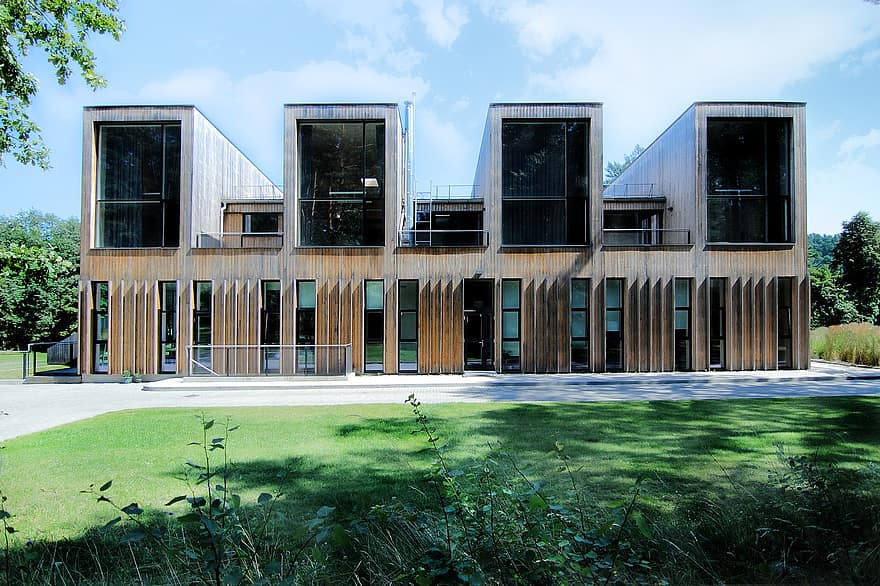Summary
– The natural wood frame
– The natural roof
– Natural walls
– The natural insulation
Do you want to build your home with natural materials but don’t know where to start? No problem, this post tells you everything you need to know. The different ways to build an ecological house are:
- The choice of natural materials as we will go through in this post.
- The selection of ecological heating.
- The construction of a bioclimatic house.
- The structure of a passive house.
Natural materials can be used at each stage of the construction, from the frame to the roof, through the walls and insulation.
The natural wood frame

What type of wooden house to build?
Wood is an ideal solution for building a solid and environmentally friendly framework. This natural material allows a quick assembly of the frame in a few days and a clean and dry building site.
In addition, wood can be combined with brick, stone, or wood panels according to preference.
For a reduced cost and a limited grey energy balance, you will take care to adopt a local wood species.
The natural roof
Roofing requires a high-quality choice of material and installation. Several options exist for a natural and robust roof.
Wood roofing
Shingles, or wood shakes, are back on the scene after being neglected.
Lightweight, insulating, environmentally friendly, and able to withstand years of use, wood shingles require a budget comparable to that of traditional clay tiles (about $30/m²).
Clay roofing
Terracotta tiles are now widely used around the world. The most natural and dye-free tiles are the most durable, lasting up to two centuries! Light, non-flammable, they are aesthetically pleasing and develop a patina over time.
There are three types of tiles and terra cotta:
– the canal tile of conical shape,
– the flat tile,
– the mechanical tile with a system of grooves allowing the interlocking.
Natural walls
Several realistic possibilities are possible to build the walls of the house.
Wooden walls
Wooden panels are frequently used in wood-frame houses. Durable, suitable hygrometric regulators, insulating and warm, they are ecologically sound.
It is important to choose wood with the FSC or PEFC label (i.e., from responsibly and sustainably managed forests) and avoid imported exotic woods.
Brick walls
A noble and natural material, brick has good thermal and sound insulation qualities. It also has good inertia and fire resistance. It is one of the most attractive ecological materials for the quality/price ratio.
Raw earth walls
Indeed, the raw earth is a perfect thermal and phonic insulator. It is the simplest and most ecological material, along with wood. It is used to build walls or to reinforce the insulation. Moreover, it is an excellent thermal regulator throughout the year.
The natural insulation
Insulation is a crucial step in the construction process since the comfort of a home depends mainly on the quality of its thermal and sound insulation. In this field, many natural and efficient solutions exist.
Cork
This insulating material, which comes from the cork oak tree, offers profound environmental and mechanical qualities. Lightweight, it is available in sheets, in bulk, or granules. It is used in non-habitable attics, floors, walls, and roofs.
It is moisture resistant, rot-proof, self-extinguishing, and stable over time.
Price: about $31/m² for 100 mm thickness.
Wood fiber
Excellent thermal insulation, it is also effective for soundproofing. Perfect for floors, walls, roofs, and partitions, it is available in rigid, semi-rigid, and loose boards.
Wood fiber insulation:
- ages well
- is not very flammable,
- and acts as a hygrometric regulator.
Price: From $15 to $20/m² for 100 mm thickness.
Hemp wool
This natural wool offers excellent thermal and phonic insulation qualities for walls, partitions, attics, and roofs. Hemp is naturally rot-proof, anti-fungal, and thermo-regulating.
Price: about $15/m².
Flax fiber
This insulation is made from flax fibers that are too short to be used in the textile industry. It is impregnated with boron salt to resist insect, rodent, mold, and fire attacks. It provides good insulation for attics, roofs, and walls. Rotproof, it resists well to fire and settling.
Price: about $15/m².
The sheep wool
It is an excellent thermal and phonic insulator, in particular on-air noises. Sheep’s wool exists in panels, rolls, felt, or in bulk. It is generally reserved for the roof and lost attic. The wool of sheep and little inflammable and tends to the auto-extinction. It is, however, reinforced with a boron salt treatment.
Price: 12 $/m² approximately in 100 mm of thickness.
Duck feathers
The thermal and phonic performances are good. Available in rolls or panels, this insulation is used for non-habitable attics, added ceilings, walls, wood-frame houses, or under floating floors.
Price: between $20 and $25/m².
Cellulose wadding
Ecological and efficient, this insulation has one of the best inertia. It can be found in panels, in bulk or granules, for many uses: lost attics, walls, partitions, floors, construction voids, false ceilings. Lightweight, cellulose wadding effectively prevents thermal bridges.
Price: $20/m² for 100 mm thickness.
Hope that this article will have brought you enough ideas on what kind of home you can build using natural materials while respecting sustainable development.


